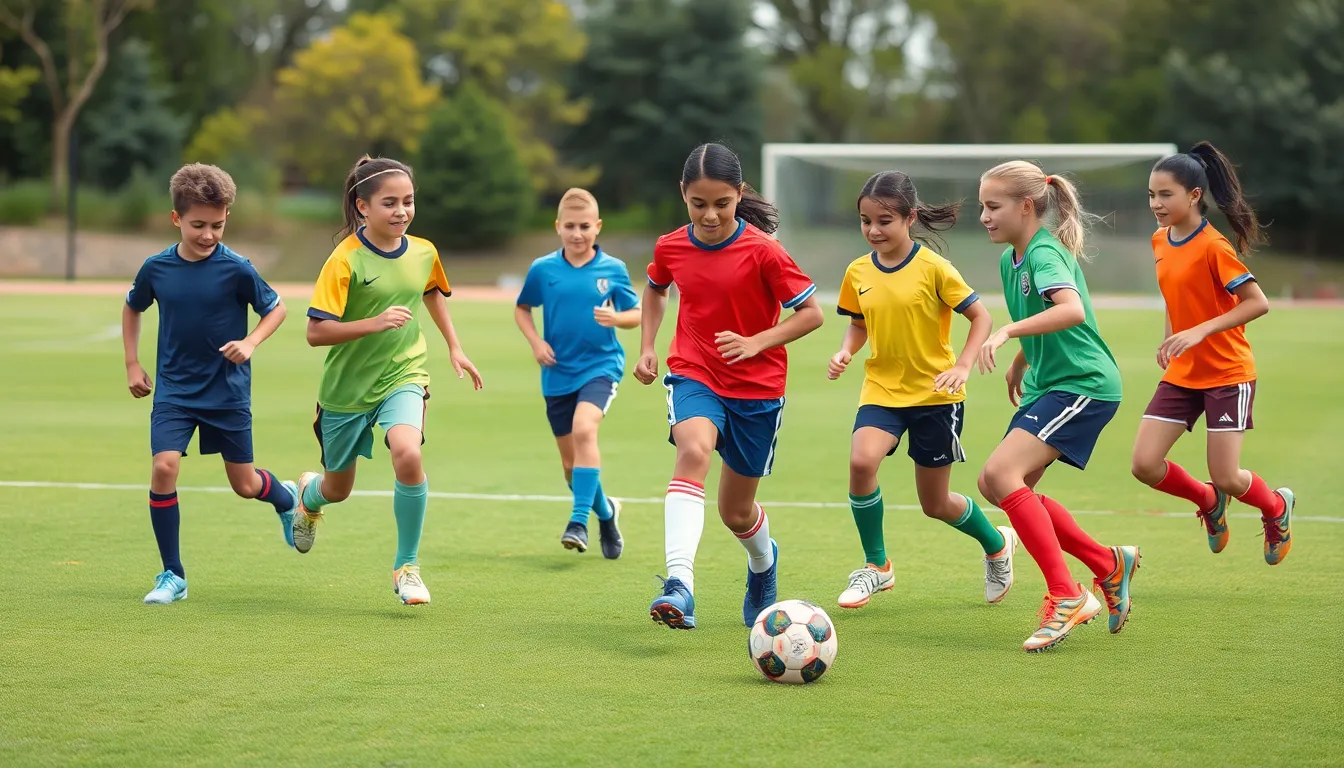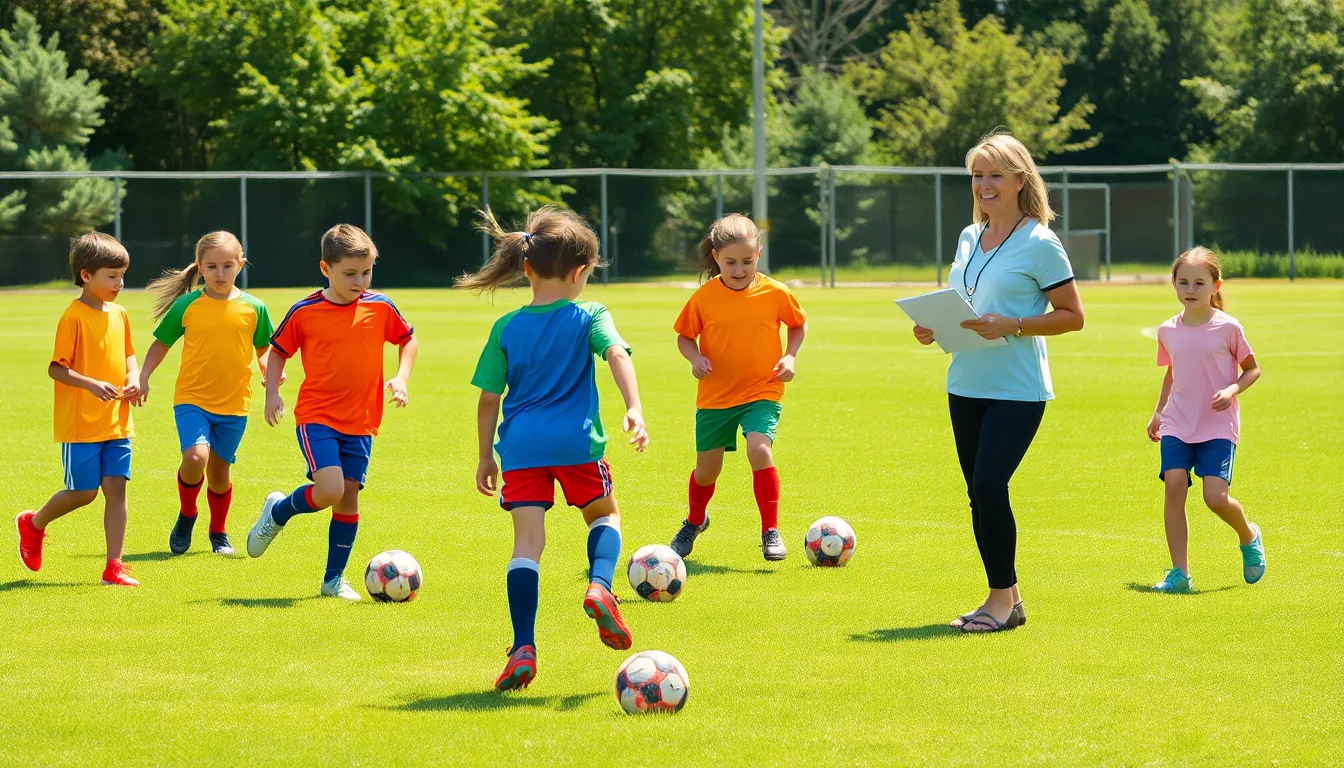Table of Contents
ToggleIn a world where video games often steal the spotlight, youth athletics stands as a vibrant beacon of energy and excitement. It’s not just about running around in circles or perfecting that killer soccer kick; it’s about building friendships, learning teamwork, and discovering the joy of movement. Who knew that chasing a ball could lead to life lessons that last far beyond the playing field?
Youth athletics offers kids a chance to unleash their inner champions while having a blast. Whether they’re dodging opponents in basketball or mastering the art of the perfect cartwheel, these young athletes are crafting memories and skills that shape their futures. So, let’s dive into the world of youth athletics, where every practice is a mini-adventure and every game is a chance to shine—because who wouldn’t want to trade a controller for a pair of cleats?
Overview of Youth Athletics
Youth athletics encompass a range of organized sports activities for children and adolescents. These programs cater to varying age groups, typically from ages 5 to 18, with a focus on inclusion and skill development. Participation in team sports like soccer, basketball, and baseball fosters social interaction, allowing kids to build friendships and develop trust with peers.
Furthermore, individual sports such as swimming, gymnastics, and tennis nurture personal growth and self-discipline. Coaches play a crucial role in facilitating these experiences, guiding young athletes in mastering skills while promoting sportsmanship and respect for opponents. Their influence shapes children’s attitudes toward competition and teamwork.
Research indicates that children engaged in sports are more likely to maintain a healthy lifestyle into adulthood. Additionally, studies highlight that youth athletic programs improve academic performance, enhancing focus and discipline. Involvement in athletics has been linked to reduced rates of depression and anxiety among young participants.
Opportunities arise through local leagues, schools, or community organizations. Many communities provide access to various sports, encouraging families to become involved and support their kids’ interests. Notably, events like tournaments and championships create memorable experiences that many young athletes cherish.
Skill development, friendships, and lifelong lessons characterize youth athletics. These elements combine to form a foundation for a well-rounded upbringing, enabling children to thrive both on and off the field.
Benefits of Youth Athletics

Participation in youth athletics offers numerous advantages that contribute to a child’s overall development. The benefits span physical and mental health, enhancing the growth of young athletes.
Physical Health Benefits
Engaging in youth athletics promotes physical fitness. Regular participation encourages cardiovascular health, strengthens muscles, and improves flexibility. Research shows that active children exhibit lower obesity rates. They gain coordination and balance skills, which enhance their performance in various activities. Injury prevention also increases as young athletes learn proper techniques. These benefits lay a foundation for lifelong fitness habits, instilling a positive attitude towards exercise.
Mental Health Benefits
Mental health improvements accompany participation in youth sports. It fosters self-esteem, as children achieve personal goals and develop skills. Social connections formed through teamwork create supportive environments, reducing feelings of loneliness. Research indicates that physical activity lowers anxiety and depressive symptoms. Young athletes often exhibit better focus and academic performance. Overall, engaging in sports cultivates resilience and a strong sense of discipline, enriching emotional well-being.
Common Sports in Youth Athletics
Youth athletics encompass a variety of engaging sports. Young athletes often choose between team sports and individual sports, each offering unique benefits.
Team Sports
Basketball, soccer, and baseball stand out as popular team sports for young athletes. Team sports encourage collaboration and communication, fostering friendships among participants. Coaches emphasize teamwork and strategy, helping players learn to work together toward common goals. Engagement in these sports boosts social skills, instilling values of responsibility and respect. Local leagues organize enjoyable competitions, enhancing the excitement of teamwork. Participation in team sports often leads to improved physical fitness, coordination, and endurance. Parents also play crucial roles, supporting their children through practices and games.
Individual Sports
Gymnastics, swimming, and tennis are prevalent individual sports that promote personal development. With a focus on self-discipline and perseverance, these sports help young athletes set and achieve personal goals. Coaches guide athletes in refining skills, ultimately boosting confidence and self-esteem. Individual sports allow participants to monitor their progress, fostering a sense of accomplishment as they improve. Additionally, they emphasize health benefits such as agility, strength, and overall fitness. Community clubs often provide opportunities for young athletes to engage in friendly competitions, enhancing both skill and enjoyment in the sport.
Challenges in Youth Athletics
Youth athletics face several challenges that can impact participants’ experiences and outcomes. Understanding these challenges is essential for fostering a positive environment.
Parental Pressure
Parental pressure significantly influences young athletes. Parents often impose high expectations on their children, pushing them toward success in competitions. Excessive focus on winning can undermine the enjoyment of sports, leading to burnout or anxiety. Children may feel compelled to specialize in one sport too early, limiting their exposure to diverse activities. Parents might also express dissatisfaction with coaches or team performance, creating additional stress. Coaches should communicate openly with parents to establish realistic goals and maintain a fun atmosphere for athletes.
Injury Risks
Injury risks represent another major challenge in youth athletics. High-intensity training and competitive play can lead to physical injuries like sprains, strains, and fractures. Young bodies are still developing, which increases their vulnerability to overuse injuries. Proper training techniques and adequate rest periods help mitigate these risks. Coaches and parents need to practice injury prevention strategies, including proper warm-ups and cool-downs. Immediate attention to injuries ensures athletes receive appropriate care, promoting a safer sports environment.
Promoting Healthy Participation
Healthy participation in youth athletics requires encouragement and support from coaches, parents, and peers. Sports programs need to foster an inclusive environment where every athlete feels valued and safe. Developing a culture of positive reinforcement enhances self-esteem and motivates children to enjoy their athletic experiences.
Implementing age-appropriate training ensures young athletes remain engaged while avoiding burnout. Coaches should focus on skill development rather than solely on competition. Encouraging diverse participation allows children to explore multiple sports, leading to a more well-rounded athletic experience.
Involvement in team sports can build vital social skills. Team dynamics contribute to friendships and help develop communication abilities. Creating opportunities for peer interaction during practices and games enhances the overall experience.
Balancing competition with fun is essential. Highlighting goal achievement, personal growth, and teamwork fosters a love for the game. Organizing fun events, such as skill challenges or mini-tournaments, promotes camaraderie and ensures an enjoyable atmosphere.
Monitoring the physical and mental health of athletes is crucial for promoting healthy participation. Coaches should prioritize injury prevention by teaching proper techniques and adhering to safety measures during training. Regular health screenings can help identify any issues early on, ensuring athletes remain healthy and active.
Establishing open lines of communication between parents, coaches, and athletes encourages discussions about feelings and expectations. Supporting mental well-being alongside physical health contributes to positive sporting experiences. Prioritizing a well-rounded approach fosters the growth of young athletes, setting them up for success both in sports and life.
Youth athletics play a vital role in shaping children’s lives. They offer a unique blend of physical activity and personal development that extends far beyond the playing field. By participating in sports, young athletes not only enhance their physical fitness but also cultivate essential life skills like teamwork and resilience.
Creating a supportive environment is key to ensuring that children can enjoy their athletic experiences. Encouragement from coaches and parents fosters a sense of belonging and helps to mitigate challenges like burnout and pressure. As youth athletics continue to evolve, the focus should remain on promoting healthy participation and creating lasting memories that contribute to a well-rounded upbringing.





